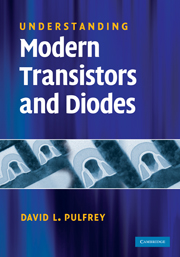Book contents
- Frontmatter
- Contents
- Preface
- 1 Introduction
- 2 Energy band basics
- 3 Electron and hole concentrations
- 4 Thermal equilibrium
- 5 Charge transport
- 6 np- and Np-junction basics
- 7 Solar cells
- 8 Light-emitting diodes
- 9 HBT basics
- 10 MOSFET basics
- 11 HJFET basics
- 12 Transistor capacitances
- 13 Transistors for high-speed logic
- 14 Transistors for high frequencies
- 15 Transistors for memories
- 16 Transistors for high power
- 17 Transistors for low noise
- 18 Transistors for the future
- Appendices
- Index
11 - HJFET basics
Published online by Cambridge University Press: 05 June 2012
- Frontmatter
- Contents
- Preface
- 1 Introduction
- 2 Energy band basics
- 3 Electron and hole concentrations
- 4 Thermal equilibrium
- 5 Charge transport
- 6 np- and Np-junction basics
- 7 Solar cells
- 8 Light-emitting diodes
- 9 HBT basics
- 10 MOSFET basics
- 11 HJFET basics
- 12 Transistor capacitances
- 13 Transistors for high-speed logic
- 14 Transistors for high frequencies
- 15 Transistors for memories
- 16 Transistors for high power
- 17 Transistors for low noise
- 18 Transistors for the future
- Appendices
- Index
Summary
Originally, the most significant difference between a MOSFET and a BJT was the high input impedance afforded by the gate insulation of the FET. The high quality of the SiO2/Si system in Si MOSFETs has not proved possible to replicate in other semiconductor systems, particularly those involving III-V compound semiconductors. Therefore, to capitalize on the advantages that the latter semiconductors may have over silicon, such as mobility (see Fig. 11.1), and still realize a FET device, some other way of implementing the field-effect is necessary. This has been done by using a metal/semiconductor junction, rather than a metal/insulator/semiconductor combination, to create a vertical field to control the charge in the channel. The two main devices that exploit this are shown in Fig. 11.2: the MESFET (metal-semiconductor FET), and the HEMT (high-electron-mobility transistor). The latter device is also sometimes called a MODFET, where MOD refers to modulation doping, and relates to the fact that the doping in the top barrier layer plays a key role in controlling (modulating) the channel charge. All these transistors are HJFETs (heterojunction FETs) on account of the presence of a metal/semiconductor heterojunction in their structures.
The use of high-mobility semiconductors in MESFETs and HEMTs enables attainment of a high transconductance, which is a prerequisite for good high-frequency perfomance (see Section 14.4).
- Type
- Chapter
- Information
- Understanding Modern Transistors and Diodes , pp. 195 - 209Publisher: Cambridge University PressPrint publication year: 2010



